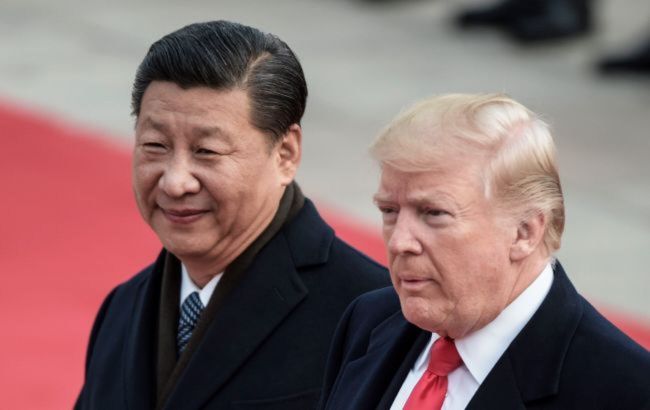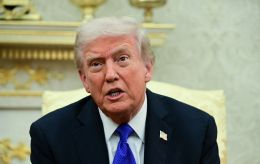Donald Trump and Xi Jinping meet for first time since 2019 - What we know and how it affects Ukraine
 Photo: US President Donald Trump and Chinese leader Xi Jinping (Getty Images)
Photo: US President Donald Trump and Chinese leader Xi Jinping (Getty Images)
US President Donald Trump met with Chinese leader Xi Jinping in South Korea, with discussions reportedly focusing on the trade war, Russia’s aggression against Ukraine, and possible paths toward ending the conflict.
RBC-Ukraine summarizes the key points from this historic meeting between the US and Chinese leaders.
According to CNN, the meeting between the leaders of the United States and China was taking place at the Kikhme Air Base, located near the international airport in Busan, South Korea.
The outlet reported that US President Donald Trump was welcoming Chinese leader Xi Jinping ahead of their long-awaited bilateral talks, during which the two were expected to outline a framework for managing their economic relations.
Key questions
-
Trump met Xi Jinping in person for the first time since beginning his second term as president.
-
Talks took place during the APEC summit in Gyeongju, covering issues such as trade, the war in Ukraine, TikTok, Taiwan, and efforts to curb fentanyl trafficking.
-
Trump aimed to secure agreements on soybean purchases and nuclear arms limits, while Beijing sought partial tariff relief and a reaffirmation of the “One China” policy.
-
The U.S. hopes China will help reduce imports of Russian energy, pressuring Moscow to end its war against Ukraine.
-
Sanctions against Rosneft and Lukoil have already led Chinese and Indian companies to scale back purchases of Russian oil.
-
Kyiv hopes Trump will persuade Xi Jinping to use his influence on Putin to bring the war to an end.
US President Donald Trump met with Chinese leader Xi Jinping for the first time since returning to the White House. It was also their first face-to-face meeting since 2019.
The talks were held on the sidelines of the APEC summit in Gyeongju and had been planned long in advance, though tensions over trade nearly derailed them. Despite early uncertainty over whether both leaders would attend, the meeting went ahead as scheduled, intending to ease tensions and defining a path for continued dialogue.
US-China trade war and the 'tariff pause'
The main focus of the meeting was trade relations between Washington and Beijing. Since beginning his second term, Trump has repeatedly called China America’s chief economic rival.
Throughout 2025, the United States raised tariffs on Chinese imports several times, reaching 145%. In response, Beijing imposed counter-tariffs of up to 125% on US goods.
On May 12, the White House announced a 90-day suspension of additional tariffs, cutting US duties to 30% and China’s to 10%. However, the situation escalated again in early October: Beijing introduced strict export controls on rare-earth elements, of which it dominates global production and refining.
On October 10, Trump countered by declaring plans to impose an additional 100% tariff on Chinese goods starting in November, which would push overall levels to 130%.
Still, the very fact that the two sides met was seen as a signal of willingness to compromise and avoid a new escalation. A "tariff pause" remains in effect until November 10, after which both sides must decide on next steps.
Trump is seeking agreements on soybean imports and nuclear arms limitations, while Beijing hopes for tariff relief and clarity on Washington’s stance toward Taiwan.
China as America's key rival
For Trump, this meeting underscored his view of China as the United States’ primary strategic and economic competitor. In recent months, he has consistently labeled Beijing as the main target of new trade restrictions.
China, in turn, is working to strengthen its autonomy in critical industries, from electronics to weapons production, and reduce its dependence on US markets.
On October 10, Trump sharply criticized Beijing’s announcement of export controls on rare-earth materials, warning that such measures could create serious challenges for many countries worldwide.

Photo: Trump has repeatedly criticized China, and Beijing has also responded (Getty Images)
At the time, the US president said he saw no need to meet with Xi Jinping, but a week later he changed his tone, referring to "positive signals" from Beijing and agreeing to hold talks with the Chinese leader in South Korea.
Trump stated that he expected a "fair deal" and a productive outcome, calling the meeting "important and promising" for both countries. He noted that the two sides had been communicating extensively in recent weeks and expressed confidence that the discussions would bring results beneficial to both nations.
War in Ukraine, Taiwan, and other issues
Among the key topics of the summit was Russia’s war against Ukraine. Trump reportedly intended to discuss China’s potential influence on Moscow and the possibility of using it to end the hostilities.
He said that he "would very much like China to help with Russia."
Ukrainian President Volodymyr Zelenskyy expressed hope that following the US-China meeting, Beijing would reduce its imports from Russia, stressing that cutting energy purchases would deprive Moscow of the resources to continue its war.
Zelenskyy added that this could become a "strong step" if China followed India’s example, as New Delhi had already signaled its intention to scale down imports of Russian energy resources.
Trump’s sanctions on Russian oil giants Rosneft and Lukoil have already triggered a reaction in both China and India. Several companies reportedly began canceling orders ahead of the November 21 deadline for the current restrictions. State-owned energy firms in both countries have started reducing oil purchases from Russia.
The US president, for his part, voiced confidence that Xi Jinping no longer had an interest in prolonging the war and might be open to finding ways to end it. Officials in Washington believe China could play a visible role in a future peace process.
While Beijing officially maintains a "neutral" stance on Russia’s war against Ukraine, calling for diplomacy and peace talks, it continues economic cooperation with Moscow, particularly in the energy and trade sectors, which effectively supports Russia’s war machine.
According to The Washington Post, China has significantly increased the supply of components for Russian drones, enabling Moscow to produce more unmanned aircraft equipped with fiber-optic systems, thereby gaining an advantage on the battlefield.

Photo: Xi Jinping and Vladimir Putin met in Beijing in September during a large military parade (Getty Images)
According to The New York Times, the leaders were also expected to discuss the situation around Taiwan. Beijing reportedly sought Washington’s reaffirmation of the One China policy and its commitment not to support the island’s independence.
The US president, however, noted that the sensitive issue of Taiwan might not be raised at all, saying he was uncertain whether it would come up and adding that "Taiwan is Taiwan."
Both sides were also expected to address the fight against fentanyl trafficking and to finalize the agreement on TikTok ownership, which had been preliminarily approved in Madrid.
For a broader look at the importance of the Trump–Xi meeting and whether it could advance efforts to end Russia’s war against Ukraine, see the analysis "Trump vs Xi showdown: What it could mean for Ukraine and rest of the world."
Sources: CNN, The New York Times, The Washington Post, Bloomberg, BBC.

